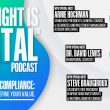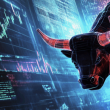by Blaine Rollins, CFA, 361 Capital
Since we last wrote three weeks ago, the news flow has actually become even more difficult for the financial markets. Seriously. This is not a dream. Check your token. Apple is going to miss earnings. The U.S. Government has shut down. The credit markets collapsed. Leading economic data points around the world continue to accelerate lower. Confusion on Syria and U.S. foreign policy. A continued, stubborn desire for The Wall. Daily POTUS tweet storms. The equity market meltdown became so severe that the Treasury department had to poll hedge fund managers to find a way to stabilize them. Huh? Eventually, it took Fed Chairman Powell to say that the Fed would change course if the bad news and data continued lower. With these helpful words, the financial markets stabilized on Friday.
Hopefully, those with over-weighted long exposures waited until Friday to untie their Bird Box blindfolds. But better keep that piece of cloth handy because investors are going to need it in the future. Earnings season is soon upon us and as Apple, Fedex and Micron already warned, it is not going to be a good time. The December correction in stocks has us prepared for missed earnings and reduced guidance. And with no progress on the China, Europe, North America, or rest of Asia trade deals, U.S. companies have little to look forward to in expanding foreign markets or lower supplier costs. To make matters worse, 800,000 government workers are not receiving paychecks this month which will ripple through the entire U.S. economy. This will affect small business loan approvals, home closings in coastal or flood zone geographies and potentially IRS tax returns. So, the company conference calls will be interesting and insightful. They will also be critical to the economic data stream since so many government agencies are closed and no longer collecting or reporting the periodic data that the financial markets rely on.
The best news out of the past three weeks was Jerome Powell’s comments on Friday suggesting that the Fed is watching the data closely and that they will act if the leading data continues to disappoint. The financial markets had already moved to discount this action by moving the odds of a Fed Funds rate cut in 2019 to 45% on Thursday. So nice to see that the markets and the Fed are moving in lockstep. Now, what will it take to get equity investor confidence back on track? End the government shutdown. Restart global trade. Give the credit markets a reason to move higher and open up for business again. Let’s see all White House news move from above the fold on A1 to the bottom of page A3 like past administrations. And let’s try and get all of this done soon because in March the debt ceiling needs to be raised again and I don’t think the U.S. is ready for two government shutdowns in one year.
How am I looking to invest from here? My focus remains on the credit markets and on the direction of earnings. We pulled in risk significantly in November when credit spreads broke higher and earnings outlooks started to get cut due to global trade worries and oil price weakness. The Ebeneezer Scrooge in us enjoyed adoring the stacks of cash during the holidays while the markets melted. But for the market to entice us to put money back into equities, it is going to have to do much more than give us cheaper P/E multiples. (Because you know that the ‘E’ in those multiples are all too high given the global economic pressures ahead.) If the credit markets heal, and liquidity again returns to the junk bond markets, then I will look to get more invested in U.S. equities. But I think the market has tipped its hat that a recession is coming. I don’t know if it is in 2019 or in 2020. And I don’t know if it will be mild or severe. But I would rather have a high cash, well hedged, low-risk portfolio today so that I can get more aggressive later this year at even lower prices. For today, cash earning 2% still appears highly attractive. Treasury bonds don’t look bad with a potential U.S. slowdown in place. And if the U.S. Dollar breaks down, then I want to have exposure to some investments overseas and will look toward Emerging Market stocks that have better growth, lower multiples and could potentially benefit from the U.S. trade issues with other countries. Bottom line, lots of risk avoidance for the time being. I wish you another great year in the markets and hope that I can continue to be of help to your portfolios and investment process.
To receive this weekly briefing directly to your inbox, subscribe now.
If you are looking to reduce risk in 2019, you have some big company…
Investors expect to continue to pile out of equities this year as they face a host of financial and geopolitical risks.
More than half (51 per cent) of 230 institutional clients overseeing $7tn surveyed by BlackRock said they would reduce exposure to the sector. The proportion was 35 per cent last year and 29 per cent in 2017.
Investors are unnerved by high share prices, the US-China trade war and uncertainty over how interest rate increases by the Federal Reserve will affect consumers…
The shift is most pronounced among UK investors, with three-quarters intending to decrease equity exposure. It is also marked among investors from the US and Canada, where almost seven in 10 plan to scale back compared with just 27 per cent in continental Europe.
Globally, only 14 per cent of investors are looking to increase exposure to stock markets, while 35 per cent anticipated no major changes.
Investors returning from the new year break are also concerned over China’s slowing economy, the chance of a no-deal Brexit and the continuing US government shutdown.
During the break, credit spreads blew out to their widest levels over this cycle…
Credit is always a big red flag for me. First because the credit markets are so big that when prices there become volatile, you must pay attention. As we saw in December, the Junk Bond markets basically were closed with no deals getting sold. Not good news for the many less-than-investment grade companies that need to refinance any existing debt. Fed Chair Powell gave a warm blanket to the credit markets on Friday which has helped in the very short term. But keep an eye on credit spreads because if we revisit the recent wides, portfolios are going to need much more than a warm blanket.
Ditto for European Credit spreads which also hit wides last week…
And when the Junk Bond market closes, so does leveraged M&A transactions…
A deal that was supposed to be the biggest leveraged buyout of 2018 has been delayed into next year by recent turmoil in the credit markets, The Post has learned.
Billionaire Leon Black’s Apollo Global Management was hoping in December to sign a roughly $20 billion deal to buy Arconic, the New York-based, aluminum-parts maker that mostly serves the aerospace industry, sources close to the talks said…
Nevertheless, insiders pointed to the quick and unexpected tightening credit markets for the delayed deal.
“Would you commit to raise $14 billion in this market?” a source said. “There is no market to finance a buyout of that size.”
(NY Post)
Wise words from BofA/MerrillLynch’s credit strategists as the credit markets get more expensive…
“Debt issuers: must find religion in deleveraging. Corporate boards should turn away from reaching for growth on borrowed money and towards rationalizing assets they own and liabilities they carry.”
All-time levels of investment grade bond outflows…
Powell’s golden message on Friday: Be patient and nimble…
Countering earlier concerns about the central bank being too rigid in its policy and insufficiently sensitive to economic risks, Powell signaled at a meeting of the American Economics Association exactly what the markets wanted to hear: The Fed would be “patient,” he and his colleagues were monitoring a broad sets of risks, all policy instruments were available for use and, therefore, the central bank wasn’t on “auto-pilot” when it comes to reducing its balance sheet.
What a crazy week for 2019 Fed Funds Rate forecasting!
Bets on a Fed rate cut soared on Thursday as Apple’s pre-announcement, bad economic data and the Government shutdown worries peaked. Then the bets reversed course on Friday after Powell’s comments.
(WSJ/DailyShot)
With stocks down and credit spreads widening, Goldman’s Financial Conditions Index is looking more painful…
J.P. Morgan showed last week that four of five markets were pricing in a 50%+ chance of a recession…
Global PMI data also showing slowing in every component of the index…
ISM new order index looks even worse for December…
Don’t look to Germany for help to buoy global trade…
@C_Barraud: #GERMANY NOV FACTORY ORDERS; Y/Y: -4.3% (largest decline since Aug. 12) V -2.7%E *Prior YoY revised lower from -2.7% to -3.0%.
Bottom line: the negative economic surprises are accelerating…
(WSJ/DailyShot)
But you could see the slowdown in Fedex earnings call…
“While the U.S. economy remains solid, our international business weakened during the quarter, especially in Europe….lower-than-expected express package volume due to European economic weakness accelerated during the quarter and is expected to continue…. global trade has slowed in recent months and leading indicators point to 3 ongoing deceleration in global trade near-term…. these trends, coupled with the change in service mix at FedEx Express, are negatively impacting the segment’s financial results”.
And also in the Micron’s earnings call…
“as we enter calendar 2019 we are seeing weakening demand from our customers. As a result we are taking decisive actions including a meaningful reduction in our fiscal 2019 CapEx plan in both DRAM and NAND that could materially reduce our supply bit growth…. we now expect DRAM bit demand growth for the industry in calendar 2019 at approximately 16% compared with our prior expectation of approximately 20%….
To receive this weekly briefing directly to your inbox, subscribe now.
Then on Thursday the White House warned us to expect many more earnings misses…
President Donald Trump’s trade war with China will force many U.S. companies to join Apple Inc. in announcing lower than expected earnings, the chairman of the White House Council of Economic Advisers said.
“It’s not going to be just Apple,” CEA chairman Kevin Hassett said in an interview on CNN. “There are a heck of a lot of U.S. companies that have sales in China that are going to be watching their earnings being downgraded next year until we get a deal with China.”
Hassett argued that a softer economy in China is cutting into U.S. companies’ sales there and that the economic pain gives Trump leverage in ongoing trade negotiations. “That puts a lot of pressure on China to make a deal,” he said.
It is as if the U.S. 2-Year Yield knew that earnings were going to weaken…
Still one of the best thermometers in the financial markets.
Markets almost always move before the data…
Semiconductors were screaming in the Fall to be careful. The group stopped making new highs and then began to breakdown on a relative basis. Finally the group broke its 200-day moving average for good and it was all over. The group told you that Apple and others were in for a rough road.
Another great risk avoidance signal was given by high quality companies…
Strong balance sheets have significantly outperformed as risks have risen across the market. Again, when the credit markets close down, you don’t want to own companies that need to get a refinancing. Stock investors have run from (and shorted) the weaker balance sheet companies during this pullback.
Unicorns…
It will be interesting to see if any of the big filed IPOs can get public this year. If they do, it probably will come at a large cost to what they thought they would receive six months ago.
Back to Earnings…
As the leading Economic data has accelerated lower, so has earnings estimate revisions…
Morgan Stanley even sees a >50% chance of an earnings recession in 2019…
A danger is lurking as the stock market dives: Earnings expectations are falling, too.
In December, analysts cut their earnings forecasts for 2019 on more than half the companies in the S&P 500, according to FactSet, the first time that had happened in two years.
For now, analysts still expect profits to keep growing in the coming year, but at a slower pace. They expect earnings for S&P 500 companies to grow 7.8% in 2019, down from their forecast of 10.1% at the end of September, according to FactSet.
That is a big climb down from the estimated 22% earnings growth rate in 2018, when corporate results were boosted by tax changes and a strong economy.
Investors are worried the moneymaking outlook for companies will deteriorate further. Equity strategists at Morgan Stanley now see a more than 50% chance of an earnings recession in 2019, defined as two consecutive quarters of earnings declines compared with the year before.
(WSJ)
Global Financial stocks have underperformed significantly…
But don’t forget that it is never fun to own balance sheet risks (loans, leases and credit) when a recession hits.
And Cyclical stocks look very cheap, but…
The ‘E’ stands for earnings and you should have little confidence in that figure right now. Just look at how quickly the Cyclical stocks went from cheap to expensive in 2007-2008 once their earnings were cut in half.
Speaking of Financial Stocks, Berkshire Hathaway has a big basket of them…
Starting in 2018, companies have been required to include in their net income some gains and losses on their equity investments that previously had been kept out of the calculation.
The change both hurt and helped Berkshire’s earnings in 2018. The company posted $6.2 billion in losses on equity investments in the first quarter, while the second and third quarters included $4.5 billion and $11.4 billion in gains, respectively.
Some of the company’s biggest holdings have now declined so sharply that the impact on its fourth-quarter earnings could be more pronounced than in the past. Apple Inc. fell 30% in the fourth quarter, which would slash more than $17 billion off the value of Berkshire’s stake if it held the shares for the entire quarter. Bank of America Corp. fell 16%, which would reduce Berkshire’s stake by $4.2 billion.Wells Fargo & Co. lost 12%, which would send Berkshire’s stake $2.9 billion lower.
(WSJ)
Will Emerging Market stocks find their footing in 2019?
They have outperformed over the last three months in this global stock pullback. Barring a global economic meltdown, they have better growth dynamics and trade at much lower multiples than the rest of the world’s equities. Finally, if the U.S. Dollar pulls back, the names and indexes could find many friendly investors.
Here is the valuation details from BofA/Merrill Lynch…
Another current market friendly chart is Gold…
But not something that you want to see if you are loaded to the gills with risk.
Sad to read about these American companies going under or moving overseas due to the new U.S. tariffs…
The steel tariffs were supposed to give American steel makers protection in the face of unfair competition from China. But Mr. Kooiker accuses American steel makers of profiteering at his expense, using the tariffs as an opportunity to raise prices by 25 percent.
“They are very much taking advantage of the situation,” he said. “As soon as they are not squeezed, they become the squeezer.”
Agritek has passed on the extra costs for steel to customers through surcharges. But it recently lost an order worth $1 million a year making steel axles used in wheeled trash bins — a major hit for a company with some $16 million in annual sales.
According to Mr. Kooiker, the customer found a supplier in China that could produce the axles more cheaply. Agritek managed to avoid layoffs by transferring the two workers who made the axles to another job, but someone else might have been hired for that work. The American steel companies he buys from lost out. The only beneficiary is the Chinese company now supplying the entire product.
“Trump is killing us,” Mr. Kooiker said. “His bang for the buck is horrible.”
(NY Times)
Now it is time for the U.S. wheat farmers to lose a top customer – Japan…
Beef and Hog farmers will also lose another top export market as their prices become price disadvantaged.
Canada is due for a larger GDP boost than if the U.S. had remained in the pact, and that comes largely at the expense of U.S. farmers who are likely to be edged out of Japanese markets. Tokyo’s regular 38.5% tariff on beef, which applies to the U.S., will fall to 9% for imports from Canada, New Zealand and Australia. Ottawa estimates total beef exports will increase 10% as a result.
U.S. Wheat Associates President Vince Peterson said in Washington last month that U.S. producers’ 53% market share in Japan risks “imminent collapse” upon implementation of the CPTPP. U.S. wheat exports to Japan will face an effective 40-cent a bushel price disadvantage with Canada and Australia.
The news isn’t much better for U.S. pork, as Europe exceeded American pork exports to Japan in dollar value in 2017 for the first time in a decade. An imminent EU-Japan free-trade agreement will increase the European advantage. U.S. pork exports to China also face a 62% duty from Beijing’s retaliation in response to Mr. Trump’s tariffs.
(WSJ)
Many young farmers are just giving up right now…
In January and February it’s the bankers who will largely decide farmers’ fates. Most farms have to borrow operating cash for each coming year to buy things like fuel, seeds and chemical fertilizer.
Right now, it’s a question of what to plant to make those costs back. Not much in dryland is making money right now. Prices are at or below cost of production in this area for wheat, barley, rapeseed, lentils, garbs and peas.
“There’s not a lot to run right now, that is the absolute truth,” McGreevy says.
McGreevy says older farmers might decide to just quit before the next go-round. But young farmers might be giving up the keys to the farm if things don’t turn around in a matter of months.
“Young farmers generally have a lot more debt that they are assuming as they are just starting off in their careers,” he says. “If they are purchasing any property, with prices that we are seeing right now, it’s very difficult to cash flow that.”
(NPR)
Imagine that. A company stretching the truth about its business model…
The Wall Street Journal compared the well-productivity estimates that top shale-oil companies gave investors to projections from third parties about how much oil and gas the wells are now on track to pump over their lives, based on public data of how they have performed to date.
Two-thirds of projections made by the fracking companies between 2014 and 2017 in America’s four hottest drilling regions appear to have been overly optimistic, according to the analysis of some 16,000 wells operated by 29 of the biggest producers in oil basins in Texas and North Dakota.
Collectively, the companies that made projections are on track to pump nearly 10% less oil and gas than they forecast for those areas, according to the analysis of data from Rystad Energy AS, an energy consulting firm. That is the equivalent of almost one billion barrels of oil and gas over 30 years, worth more than $30 billion at current prices. Some companies are off track by more than 50% in certain regions.
(WSJ)
Lower oil prices not a positive for an American economy now leveraged to exporting energy…
Goldman Sachs Group Inc. cut its oil price forecasts for 2019, citing a re-emerging surplus and resilient U.S. shale production.
Global benchmark Brent crude will average $62.50 a barrel this year, analysts including Damien Courvalin said in a Jan. 6 note, down from a previous estimate of $70. U.S. marker West Texas Intermediate will average $55.50 a barrel, down from a prior forecast of $64.50…
A surge in OPEC production in late 2018 means the market started this year better supplied than the last, and pipeline constraints in the U.S. Permian Basin will clear up faster than expected, according to Goldman. Big projects in the works for years in Brazil and Canada will also ramp up output in 2019. Combined, those increases mean fewer high-cost marginal barrels will be needed to meet global demand growth this year, Courvalin said.
End of an era for the automobile engine…
Sales of internal combustion engine cars in 2018 are unlikely to be surpassed in any future year, as demand in the world’s three largest markets stalls and carmakers seek to ramp up production of electric cars.
“We will probably see the peak of combustion engine car sales in 2018 based on global sales through October, plus estimates for November and December,” said Felipe Munoz, global automotive analyst at Jato Dynamics, a supplier of automotive data.
“At the beginning of the year we had a more optimistic perspective for the global market. This has changed in the last six months.”
That idea that combustion engines would be displaced by “zero emission” technology has become mainstream in recent years, but predictions at the start of 2018 generally held that demand would keep growing until 2022 or later.
However, the global car market in recent months has been characterised as “disastrous” by one analyst and a “nightmare” by another, owing to the US-led trade war, Brexit, financing issues among Chinese consumers, the embargo on Iran and new emissions targets in Europe.
Toronto is now adding more tech jobs than San Francisco, Seattle and D.C. combined!
People like Mr Rangnekar are part of an exodus of tech workers from Silicon Valley. Pushed out by the cost of living as well as by a less welcoming American government, they are being pulled in by countries such as Canada, where tech vacancies are forecast to reach 200,000 by 2020. Canada is gambling that by the time America wakes up to the cost of discouraging immigrants its tech sector will have secured some of the best talent.
The starting-point is pretty promising. Toronto already has expertise in artificial intelligence (ai) and an array of promising firms such as Wattpad, a storytelling platform with 65m readers. The city added more tech jobs in 2017 than the San Francisco Bay area, Seattle and Washington, dc, combined. Ottawa is home to Shopify, a publicly traded e-commerce platform valued at C$19bn ($14bn). Montreal, another ai hotbed, has Element ai, a lab co-founded by Yoshua Bengio, a specialist in deep learning—and newish labs opened by Facebook and Samsung.
Yet Canada is in the third tier of destinations globally, says a study on venture-capital investment, “The Rise of the Global Start-Up City”, co-authored by Richard Florida, an urbanologist. To move up, the government has tweaked both its permanent and temporary immigrant programmes. Applicants for permanent residence get extra points for tech skills. Temporary visa holders are told their spouses will be allowed to work. Justin Trudeau, the prime minister, often underlines that in multicultural Canada, diversity is welcomed. Publicly funded health care sometimes gets a mention.
So another year in our lives has passed…
A reminder from Ali to to get out of our comfort zone, walk in another man’s shoes and read something new and different.
That said, this book, “The Third Plate” is blowing my mind…
For a quick snapshot, check out Chef’s Table Season 1, Episode 2 on Dan Barber. The book is an incredible read and will get you thinking. Jealous of everyone who has eaten at Blue Hill. Definitely on my bucket list for 2019.
Dan Barber, an award-winning chef, moves beyond “farm-to-table” to offer a revolutionary new way of eating. After more than a decade spent investigating farming communities around the world in pursuit of singular flavor, Barber finally concluded that–for the sake of our food, our health and the future of the land—America’s cuisine required a radical transformation.
Drawing on the wisdom and experience of chefs, farmers and seed breeders around the world, Barber proposes a new definition for ethical and delicious eating.
Barber charts a bright path forward for eaters and chefs alike, daring everyone to imagine a future for our national cuisine that is as sustainable as it is delicious.











































